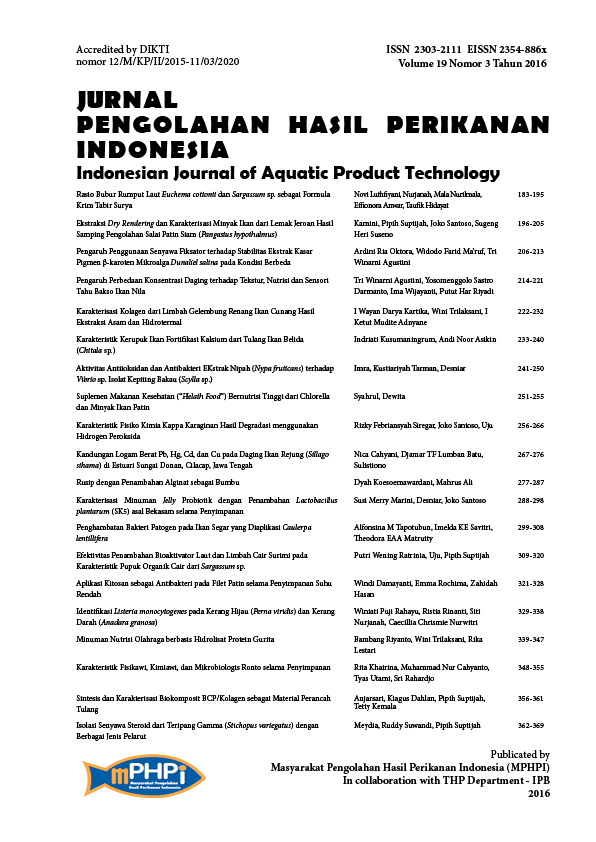Extraction by Dry Rendering Methode and Characterization Fish Oil of Catfish Viscera Fat by Product of Smooked Fish Processing
Abstrak
Abstract
The catfish viscera fat, is cathfish processing by-products, has potential to be used as a source of raw
material for production of fish oil. This study aimed to analyze the value of proximate, heavy metal content
and fatty acid profile of catfish viscera fat (Pangasius hypopthalmus) and characterized fish oil extracted by
dry rendering in various temperature and time than compared it to fish oil extracted by stove heating to
obtain the best treatment. Proximate, heavy metal residue, and the fatty acid profile analysis were conducted
for characterizing catfish viscera fat. Fish oil extraction was conducted by dry rendering in various
temperatures of 50, 60, 70, 80 °C for 1, 2, and 3 hours. Fish oil quality was determined by the chemical
characteristics i.e. PV, FFA, anisidin and TOTOX. The results of the study showed that fat content of catfish
fat viscera was 88.19 %, the heavy metals content was below SNI standart to be consumed, and fatty acid
profile composition was SFA>MUFA>PUFA. The highest fatty acid content was oleic acid. The best fish oil
quality was resulted on temperature extraction of 50°C for 2 hours with yield value, PV, FFA, anisidin, and
TOTOX were 45.17 %, 2.77 meq/kg, 0.83 %, 2.86 meq/kg, 8.39 meq/kg respectively. This result was not
significantly different with fish oil extracted by the stove heating expect for yield and PV were 80.11% and
6.52 meq/kg, respectively.
The catfish viscera fat, is cathfish processing by-products, has potential to be used as a source of raw
material for production of fish oil. This study aimed to analyze the value of proximate, heavy metal content
and fatty acid profile of catfish viscera fat (Pangasius hypopthalmus) and characterized fish oil extracted by
dry rendering in various temperature and time than compared it to fish oil extracted by stove heating to
obtain the best treatment. Proximate, heavy metal residue, and the fatty acid profile analysis were conducted
for characterizing catfish viscera fat. Fish oil extraction was conducted by dry rendering in various
temperatures of 50, 60, 70, 80 °C for 1, 2, and 3 hours. Fish oil quality was determined by the chemical
characteristics i.e. PV, FFA, anisidin and TOTOX. The results of the study showed that fat content of catfish
fat viscera was 88.19 %, the heavy metals content was below SNI standart to be consumed, and fatty acid
profile composition was SFA>MUFA>PUFA. The highest fatty acid content was oleic acid. The best fish oil
quality was resulted on temperature extraction of 50°C for 2 hours with yield value, PV, FFA, anisidin, and
TOTOX were 45.17 %, 2.77 meq/kg, 0.83 %, 2.86 meq/kg, 8.39 meq/kg respectively. This result was not
significantly different with fish oil extracted by the stove heating expect for yield and PV were 80.11% and
6.52 meq/kg, respectively.
Penulis
KaminiK., SuptijahP., SantosoJ., & SusenoS. H. (2017). Extraction by Dry Rendering Methode and Characterization Fish Oil of Catfish Viscera Fat by Product of Smooked Fish Processing. Jurnal Pengolahan Hasil Perikanan Indonesia, 19(3), 196-205. https://doi.org/10.17844/jphpi.v19i3.15071
##submission.howToCite.downloadCitation##
##plugins.generic.citationStyleLanguage.download.ris##
##plugins.generic.citationStyleLanguage.download.bibtex##
Authors who publish with this journal agree to the following terms:
- Authors retain copyright and grant the journal right of first publication with the work simultaneously licensed under a Creative Commons Attribution License that allows others to share the work with an acknowledgement of the work's authorship and initial publication in this journal.
- Authors are able to enter into separate, additional contractual arrangements for the non-exclusive distribution of the journal's published version of the work (e.g., post it to an institutional repository or publish it in a book), with an acknowledgement of its initial publication in this journal.





